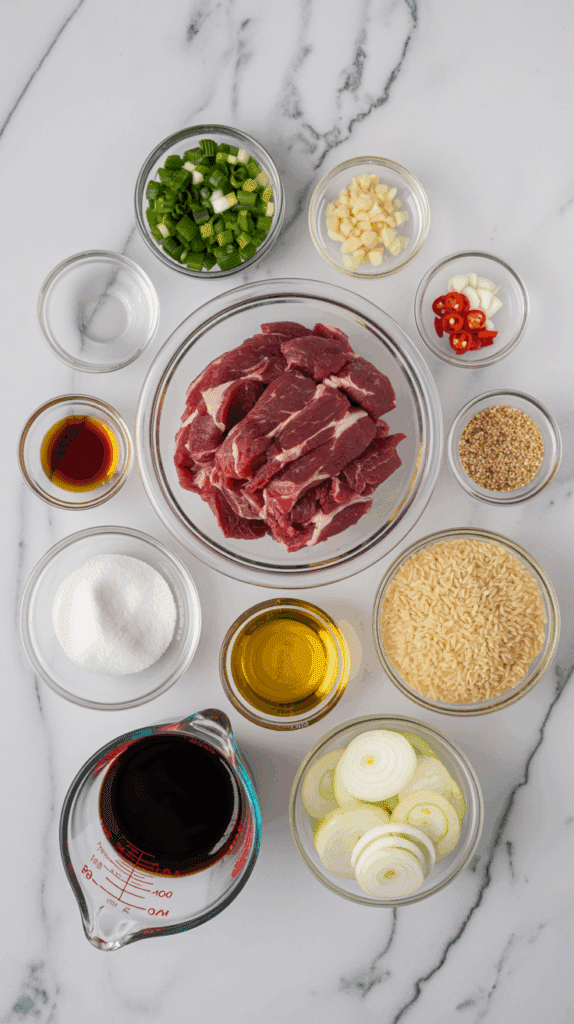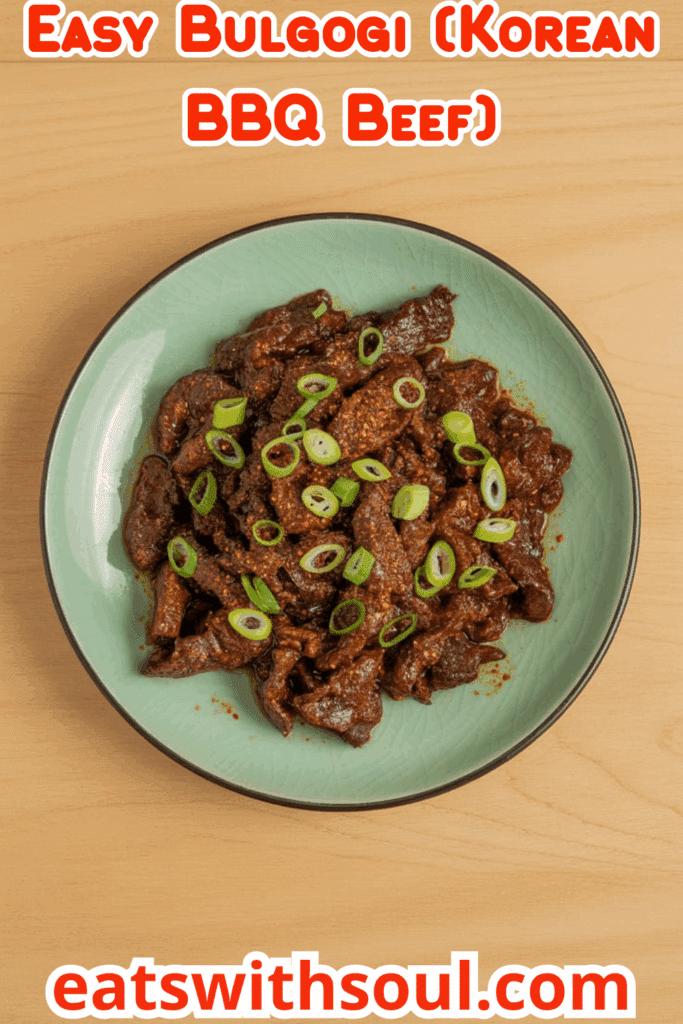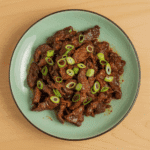Introduction & Inspiration
If you’re a fan of those incredibly flavorful, slightly sweet, and savory marinated grilled meats from Korean barbecue restaurants, then you are going to absolutely adore this Easy Homemade Bulgogi recipe! “Bulgogi,” which literally means “fire meat,” features tender, thinly sliced beef (sirloin is great here!) marinated in a delicious concoction of soy sauce, green onions, garlic, ginger, sesame oil, a touch of sweetness from sugar and honey, and a hint of Korean red pepper flakes. It’s then quickly cooked in a hot wok or skillet until beautifully caramelized.
My inspiration for this recipe comes from wanting to capture that irresistible, authentic Bulgogi flavor in a way that’s totally achievable for home cooks. While restaurant Bulgogi often involves special grills, this version comes together beautifully in a simple skillet or wok, delivering all that wonderful taste with minimal fuss.
This dish is perfect for a quick and exciting weeknight dinner, a fun weekend meal, or anytime you’re craving a burst of delicious Korean barbecue flavor. It’s wonderfully aromatic and so satisfying! It is a perfect recipe for Korean BBQ lovers.
Nostalgic Appeal / Comfort Factor
Korean barbecue, and Bulgogi in particular, has gained immense popularity worldwide and holds a special appeal for many. It’s often associated with fun, interactive dining experiences, sizzling platters, and a delightful combination of savory, sweet, and umami flavors. For those familiar with Korean cuisine, it’s a taste of home or cherished restaurant memories.
Even for newcomers, the combination of tender, marinated beef with those distinct soy, sesame, garlic, and ginger notes is incredibly comforting and satisfying. It’s a dish that feels both excitingly flavorful and deeply nourishing.
Making Bulgogi at home brings the fun and deliciousness of Korean barbecue right to your own kitchen. A perfect dish to share with family and friends.
Homemade Focus
This recipe is all about creating authentic Bulgogi flavor from scratch using fresh ingredients and simple techniques. You’re preparing fresh aromatics like green onions, yellow onion, garlic, and ginger, and whisking together a classic Bulgogi marinade yourself using pantry staples like soy sauce, sugar, sesame oil, and spices.
The homemade focus lies in the marinating process, which tenderizes the beef and deeply infuses it with flavor, and in the quick stir-frying or searing technique that results in beautifully caramelized meat. Slicing the steak very thinly yourself (or having your butcher do it) is also a key homemade step for achieving the right texture.
It celebrates how easily you can create a globally inspired, restaurant-quality dish at home by focusing on fresh ingredients and fundamental cooking methods. The homemade marinade is incredible.
Flavor Goal
The primary flavor goal is tender, thinly sliced beef thoroughly imbued with a classic Bulgogi flavor profile: a perfect balance of savory (from soy sauce), sweet (from sugar and honey), nutty (from sesame oil and seeds), aromatic (from garlic, ginger, and onions), with a very subtle warmth from Korean red pepper flakes.
The beef should be incredibly tender due to the thin slicing and marination. The quick cooking process over medium-high heat, with the addition of honey towards the end, should create lovely caramelized edges on the meat. The marinade itself reduces slightly to form a delicious glaze.
The overall experience should be succulent, flavorful, slightly sweet, savory, and aromatic beef that melts in your mouth, perfect served over rice or in lettuce wraps. A perfect balance between flavour and texture.
Ingredient Insights
- Beef Sirloin Steak (1 ½ pounds): A good choice for Bulgogi as it’s relatively tender and flavorful. The key is to slice it very thinly against the grain. Partially freezing the steak for 30-60 minutes makes thin slicing much easier. Other tender cuts like ribeye or tenderloin also work, or even flank steak if sliced very thinly.
- Soy Sauce: The savory, umami backbone of the marinade. Use a good quality Korean or Japanese soy sauce if possible, or standard low-sodium soy sauce.
- Green Onions: Adds fresh, mild onion flavor. The white and light green parts are typically minced and added to the marinade, while the dark green parts are reserved for garnish.
- Yellow Onion (Thinly Sliced): Adds sweetness and aromatic depth to the marinade and cooks down with the beef.
- White Sugar & Honey: Provide sweetness to balance the soy sauce and aid in caramelization during cooking. Honey is added during the cooking process for a final glaze.
- Garlic (Minced) & Fresh Ginger (Minced/Grated): Essential fresh aromatics that provide pungency, warmth, and signature Korean flavor.
- Toasted Sesame Seeds & Sesame Oil: Provide crucial nutty aroma and flavor. Use toasted sesame oil for the most intense flavor.
- Korean Red Pepper Flakes (Gochugaru): Adds a mild, smoky heat and vibrant red color. It’s different from standard crushed red pepper flakes, offering more flavor than just heat. Adjust amount to taste or omit if preferred.
- Ground Black Pepper: Adds a touch of warmth.
- Kitchen Shears (for cutting steak): The recipe suggests using kitchen shears to cut the steak very thin, which can be easier than a knife for some. A very sharp knife also works perfectly.
Essential Equipment
- Large Glass or Ceramic Bowl: For marinating the beef (avoid metal bowls with acidic marinades if marinating for extended periods, though 1 hour is fine).
- Whisk: For combining the marinade ingredients.
- Sharp Knife or Kitchen Shears: Essential for slicing the beef very thinly against the grain.
- Cutting Board:
- Wok or Large Skillet: Ideal for quickly cooking the beef in batches over medium-high heat. Needs to retain heat well for a good sear/caramelization.
- Tongs or Cooking Chopsticks/Spatula: For stirring and cooking the beef.
- Measuring Cups & Spoons:
- Grater or Microplane (Optional): For grating fresh ginger easily.
Ingredients
(Based on 1x column)
- ▢ 1 ½ pounds beef sirloin steak, cut very thinly against the grain
- ▢ ⅓ cup soy sauce
- ▢ 2 green onions, chopped (dark green parts separated from white and light green parts for garnish)
- ▢ ¼ yellow onion, thinly sliced
- ▢ 3 tablespoons white sugar
- ▢ 3 cloves garlic, minced
- ▢ 2 tablespoons toasted sesame seeds
- ▢ 1 tablespoon toasted sesame oil
- ▢ ¼ teaspoon Korean red pepper flakes (gochugaru), or to taste
- ▢ ¼ teaspoon minced fresh ginger
- ▢ ⅛ teaspoon ground black pepper
- ▢ 1 teaspoon honey, or to taste (for finishing)
Garnish:
- ▢ Reserved dark green parts of green onions, chopped

Step-by-Step Instructions
1. Prepare Aromatics and Marinade:
- Finely chop the white and light green parts of the 2 green onions. Thinly slice the ¼ yellow onion. Mince the 3 cloves of garlic and the fresh ginger. Reserve the dark green parts of the green onions for garnish later.
- In a large glass or ceramic bowl, whisk together the soy sauce, the chopped white and light green parts of the green onions, sliced yellow onion, white sugar, minced garlic, toasted sesame seeds, toasted sesame oil, Korean red pepper flakes (gochugaru), minced ginger, and ground black pepper until the sugar is mostly dissolved.
2. Slice and Marinate Steak:
- If not already done, slice the sirloin steak very thinly against the grain. Using kitchen shears as suggested can make this easier, or use a very sharp knife. Partially freezing the steak for 30-60 minutes firms it up for easier thin slicing.
- Add the thinly sliced steak to the bowl with the marinade. Toss well with your hands or tongs to ensure every piece is evenly coated.
- Cover the bowl with plastic wrap and marinate in the refrigerator for at least 1 hour to allow the flavors to penetrate the beef. For deeper flavor, you can marinate for up to 1 day (24 hours).
3. Cook the Bulgogi:
- Heat a wok or large, heavy-bottomed skillet over medium-high heat until hot. (You likely won’t need additional oil if your wok/skillet is well-seasoned and due to the oil in the marinade, but add a teaspoon if prone to sticking).
- Working in batches to avoid overcrowding the pan (which would steam the meat instead of searing it): Add a portion of the marinated steak and some of its marinade to the hot skillet.
- Stir-fry, cooking and stirring frequently, for about 3-5 minutes.
- During the last minute or two of cooking for each batch, drizzle in a little of the honey (about 1/3 of the teaspoon per batch, or to taste) and continue to cook and stir until the steak is cooked through, slightly caramelized, and the marinade has reduced to a light glaze.
- Remove the cooked batch from the skillet and set aside. Repeat with the remaining marinated steak and marinade, adding more honey to each batch.
4. Garnish and Serve:
- Once all the Bulgogi is cooked, you can return all of it briefly to the wok/skillet to ensure it’s hot if needed.
- Transfer the cooked Bulgogi to a serving platter or individual bowls.
- Garnish generously with the reserved chopped dark green parts of the green onions.
- Serve immediately while hot.

Troubleshooting
- Steak Tough: Not sliced thinly enough, sliced with the grain instead of against it, or overcooked. Thin slicing against the grain is paramount. Cook quickly in batches over medium-high heat.
- Too Salty: Soy sauce brand very salty, or too much added. Use low-sodium soy sauce if preferred. Sugar/honey help balance.
- Too Sweet: Used too much sugar or honey. Adjust to taste.
- Sauce Burning in Pan: Heat too high for the sugar/honey content, or pan overcrowded causing marinade to pool and burn before meat cooks. Cook in batches, maintain medium-high heat, stir frequently, and add honey only towards end of each batch’s cooking.
- Uneven Cooking: Pan overcrowded, or meat not sliced uniformly. Cook in batches.
Tips and Variations
- Thin Slicing is Key: For tender Bulgogi, slice the beef as thinly as possible against the grain. Partially freezing the steak for 30-60 minutes makes this much easier.
- Marinating Time: At least 1 hour, but 4-8 hours or even overnight yields deeper flavor.
- Don’t Overcrowd Pan: Cook in batches for proper searing and caramelization rather than steaming.
- Korean Pear or Apple: Traditionally, grated Asian pear or apple is often added to Bulgogi marinades for tenderness and subtle sweetness (about 1/4 cup grated).
- Different Cuts: Thinly sliced ribeye is a premium choice for Bulgogi. Flank steak or skirt steak also work if sliced very thin against the grain.
- Vegetables: Add thinly sliced mushrooms, carrots, or bell peppers to the wok/skillet along with the beef during the last few minutes of cooking for a more complete meal.
- Spice Level: Adjust the amount of Gochugaru (Korean red pepper flakes) to your preference.
- No Wok? A large, heavy-bottomed skillet (cast iron or stainless steel) works well.
Serving and Pairing Suggestions
- Serve Hot: Best enjoyed immediately.
- With Rice: Classic serving method over steamed short-grain white rice.
- Lettuce Wraps (Ssam): Serve with crisp lettuce leaves (like butter lettuce or romaine) for wrapping the Bulgogi, often with ssamjang (Korean dipping sauce) and rice.
- Korean Side Dishes (Banchan): Accompany with small bowls of kimchi, seasoned spinach (sigeumchi namul), pickled radish (danmuji), etc.
- Bulgogi Bowls: Create a bowl with rice, Bulgogi, sautéed veggies, and a sprinkle of sesame seeds.
Nutritional Information
(Note: Estimated, per serving, assuming 4 servings. Variable based on beef cut/trimming, exact amount of sugar/honey/soy sauce.)
- Calories: 350-450+
- Fat: 15-25g+
- Saturated Fat: 5-10g+
- Cholesterol: 70-100mg+
- Sodium: 800-1200mg+ (Soy sauce is high)
- Total Carbohydrates: 20-30g+ (Mostly from sugar/honey)
- Dietary Fiber: 1-2g+
- Sugars: 15-25g+
- Protein: 30-40g+
Easy Homemade Bulgogi (Korean BBQ Beef)
Make delicious and Easy Homemade Bulgogi! This Korean BBQ Beef recipe features thinly sliced sirloin marinated in a savory-sweet soy, sesame, ginger, and garlic sauce, then quickly stir-fried.
Ingredients
(Based on 1x column)
- ▢ 1 ½ pounds beef sirloin steak, cut very thinly against the grain
- ▢ ⅓ cup soy sauce
- ▢ 2 green onions, chopped (dark green parts separated from white and light green parts for garnish)
- ▢ ¼ yellow onion, thinly sliced
- ▢ 3 tablespoons white sugar
- ▢ 3 cloves garlic, minced
- ▢ 2 tablespoons toasted sesame seeds
- ▢ 1 tablespoon toasted sesame oil
- ▢ ¼ teaspoon Korean red pepper flakes (gochugaru), or to taste
- ▢ ¼ teaspoon minced fresh ginger
- ▢ ⅛ teaspoon ground black pepper
- ▢ 1 teaspoon honey, or to taste (for finishing)
Garnish:
- ▢ Reserved dark green parts of green onions, chopped
Instructions
1. Prepare Aromatics and Marinade:
- Finely chop the white and light green parts of the 2 green onions. Thinly slice the ¼ yellow onion. Mince the 3 cloves of garlic and the fresh ginger. Reserve the dark green parts of the green onions for garnish later.
- In a large glass or ceramic bowl, whisk together the soy sauce, the chopped white and light green parts of the green onions, sliced yellow onion, white sugar, minced garlic, toasted sesame seeds, toasted sesame oil, Korean red pepper flakes (gochugaru), minced ginger, and ground black pepper until the sugar is mostly dissolved.
2. Slice and Marinate Steak:
- If not already done, slice the sirloin steak very thinly against the grain. Using kitchen shears as suggested can make this easier, or use a very sharp knife. Partially freezing the steak for 30-60 minutes firms it up for easier thin slicing.
- Add the thinly sliced steak to the bowl with the marinade. Toss well with your hands or tongs to ensure every piece is evenly coated.
- Cover the bowl with plastic wrap and marinate in the refrigerator for at least 1 hour to allow the flavors to penetrate the beef. For deeper flavor, you can marinate for up to 1 day (24 hours).
3. Cook the Bulgogi:
- Heat a wok or large, heavy-bottomed skillet over medium-high heat until hot. (You likely won’t need additional oil if your wok/skillet is well-seasoned and due to the oil in the marinade, but add a teaspoon if prone to sticking).
- Working in batches to avoid overcrowding the pan (which would steam the meat instead of searing it): Add a portion of the marinated steak and some of its marinade to the hot skillet.
- Stir-fry, cooking and stirring frequently, for about 3-5 minutes.
- During the last minute or two of cooking for each batch, drizzle in a little of the honey (about 1/3 of the teaspoon per batch, or to taste) and continue to cook and stir until the steak is cooked through, slightly caramelized, and the marinade has reduced to a light glaze.
- Remove the cooked batch from the skillet and set aside. Repeat with the remaining marinated steak and marinade, adding more honey to each batch.
4. Garnish and Serve:
- Once all the Bulgogi is cooked, you can return all of it briefly to the wok/skillet to ensure it’s hot if needed.
- Transfer the cooked Bulgogi to a serving platter or individual bowls.
- Garnish generously with the reserved chopped dark green parts of the green onions.
- Serve immediately while hot.
Recipe Summary and Q&A
Summary: This Easy Homemade Bulgogi involves marinating very thinly sliced sirloin steak in a sauce made from soy sauce, green onions, yellow onion, sugar, garlic, toasted sesame seeds and oil, Korean red pepper flakes, ginger, and black pepper for at least 1 hour. The marinated steak (with some marinade) is then cooked quickly in batches in a hot wok or skillet, with honey added during the last minute of cooking each batch for caramelization, until cooked through. It’s garnished with more green onions and served hot.
Q&A:
- Q: What’s the best way to slice the beef thinly?
- A: Partially freeze the steak for about 30-60 minutes until it’s very firm but not frozen solid. This makes it much easier to get super thin slices with a sharp knife, cutting against the grain. Or, as the recipe suggests, kitchen shears can sometimes work well for this.
- Q: What is Gochugaru (Korean red pepper flakes)? Can I substitute regular red pepper flakes?
- A: Gochugaru is a specific type of Korean chili powder/flake that has a unique smoky, slightly sweet, and fruity flavor with moderate heat. Standard crushed red pepper flakes are generally much hotter and have a different flavor profile. If substituting, use much less (e.g., 1/8 tsp or to taste) and expect a different kind of heat. Gochugaru can be found in Korean markets or online.
- Q: Can I prepare the marinade or marinate the beef ahead of time?
- A: Yes! The marinade can be whisked together a day or two in advance and stored in the fridge. The beef can marinate for up to 24 hours in the refrigerator for maximum flavor.
- Q: Why cook in batches?
- A: Cooking in batches prevents overcrowding the wok or skillet. If the pan is too full, the temperature will drop, and the meat will steam in its own juices rather than searing and caramelizing properly. Searing in batches ensures each piece gets good contact with the hot surface.

